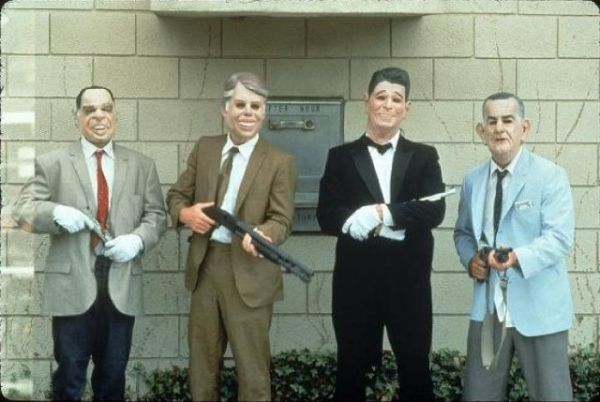The Great War has cast a long shadow and we are living with its
effects today, as much from the defects of our understanding as the war…

David Reynolds’
The Long Shadow: The Legacies of the Great War in the Twentieth Century
(2014) is one of those rare books that is as good as its press. But it
is not a book to be simply read, but to be read and absorbed.
The Long Shadow
is, as we are told it will be by reviewers, thought-provoking: In its
approximately 400 pages, this book explains the huge role played by the
Great War in shaping the twentieth century, and even the force it has
continued to exert in the twenty-first.
We tend to see the Great War as a monolithic thing,
but it was a great many things to a great many different people, from
those who experienced it first hand, to those who grew up in its shadow,
and to those growing up in a world where the last veteran has died.
And it was a great many different things to the
nations that fought it. As Reynolds points out, the twentieth century
also shaped the Great War “in its own light, with different nations and
eras persistently reinterpreting the conflict through their own
preoccupations.”
Great Britain’s direct experience of the war from
safely across the channel was very different than that of France, over
which trench warfare raged for five years, let alone that of Russia,
which saw defeat and civil war (and the resultant consignment of the
Great War to ‘ideological oblivion’), or that of Germany, defeated, but
in its own mind, not defeated but betrayed. And America, 3,000 miles
across the Atlantic, had a different experience altogether.
Not only did these countries deal with staggering
numbers of casualties, in dead and wounded and psychologically
destroyed, but there was the economic cost, and the societal changes
forced on them by years of total war, for example, the expansion of the
voting franchise, not only to women, but to men who had found themselves
able to fight but not to vote. All that changed. Think about it:
Reynolds tells us that a quarter of the adult male population of the UK
served in the British army, with an unbelievable 43 percent of those
being volunteers.
Whereas before these largely property-less men could
not vote, those who were previously seen as rootless were in the wake of
victory now seen as patriotic. As of 1918, all men over 21 and soldiers
of any age, Reynolds tells us, could vote (conscientious objectors
could not). Then there were the 800,000 women working in the munitions
industry, the Rosie and Riveters of their time, called “Tommy’s sister”
(a British soldier was a ‘Tommy’).
Not all women, just as not all men, earned the right
to vote as a result of the war, but women over the age of 30 who were
“householders or their wives” earned the right to vote, as did women
university graduates (the vote did not reach the other women until
1928). The problem was, the powers that be did not want an electorate
that had more female voters than male because women vote based on
emotion and looks, don’t you know.
Change came, but if change was incremental, it was
also significant. The world of 1918 and into the 20s and 30s was not the
world of 1914. How drastically that post-war world varied depended upon
where you lived, safely in America or England, or a ruined Germany or
Eastern Europe and Russia, where the end of the Great War did not bring
an end to war.
The Great War saw not only fighting on the front
lines, but commerce raiding and submarine warfare on the world’s oceans,
shortages of food and other resources, strikes, violence in Ireland (to
become a war for independence in 1919), and mutinies on the front
lines.
As “peace” came in 1918, the West had respite, but
Eastern Europe and the Balkans sank into chaos, as did the old Ottoman
Empire, and in China, as a result of the Paris Peace Conference, we saw
Mao Zedong turn to communism with consequences of which we have yet to
see the conclusion.
The Baltic States of Latvia, Lithuania and Estonia
made themselves independent (and had to fight to show they meant it) as
did Poland. The Ukraine even tried for a short-lived independence but
was divided instead at the Paris Peace Conference between Poland and
Russia. Yugoslavia and Czechoslovakia arose out of what had been the
Austro-Hungarian Empire, and in the Balkans, the Great War was more a
continuation of a series of Balkan Wars, dating back not to 1914 but to
1912, a Third Balkan War to follow the Second.
The Long Shadow points to the different
ways in which the war was remembered as time passed (If you think this
sounds strange, look at how quickly we were able to ‘remember’ we were
fighting to spread democracy in Iraq rather than for revenge). As
Reynolds tells us, what we think of as the “interwar years” between the
Great War and World War Two, were the “post-war years” for
contemporaries, years whose failures only became apparent after 1939,
and he recommends in our attempts to understand that we try to view that
period as contemporaries saw them. But after a second world war had
begun, some started to see the Great War as only the first part of a
thirty years war. The Great War itself became the ‘First World War.’
Only now, he says, is some detachment from the
conflict possible. From early and strictly nationalist memorials we have
seen the rise of ‘remembrance as reconciliation’ with joint monuments
to the dead. One of these is at Kobarid (old Caporetto), where, in one
of those ironies of history, hundreds of thousands of Italians died or
became casualties in a dozen futile battles during the First World War
for a slice of real estate that would, as a result of a right wing shift
in response to a Marxism unleashed by that war, end up as part of
Slovenia after the Second.
The changes wrought on America, and by
America on the world, were also extensive, and we are feeling their
effects still (as is Iraq). The World was the recipient of the idea of
being made “safe for democracy,” what Reynolds calls the “Wilsonian
vision.” For America, the Great War became the first phase of American
leadership, with the Second World War finishing the task. And the Great
War, which had been seen as a mistake before the Second World War, now
was reinterpreted as a “stepping stone” and a “second chance” to spread
democracy.
And it’s not only what we did to the world with this
second chance, but what we did to ourselves. Europe faced firsthand the
spread of Marxism, and on the continent the response was a rise of an
equally diabolical wingnut fascism, but as Reynolds points out,
though the United States withstood Marxism, “the backlash against alien
radicalism was in its own way destabilizing. Wartime ‘100% Americanism’
and the postwar Red Scare, though a brief spasm, laid the basis for a
Manichean ideology of hyperpatriotism and vehement animosity toward the
political left.”
When we think of recent repugican efforts to
de-legitimize all things Democrat, we must realize that this demonetization
has, by now, a century-long history.
The Great War has cast a long shadow indeed, and we
are living with its effects today, but as much from the defects of our
understanding of the war as because of the real changes it wrought. We
must seek to understand the past, but realize that through our
understanding, we are also shaping it through the lens of the present,
because we have no other perspective from which to view it.
It is all too easy, as events have proved, to put a
spin on the past to serve the needs of the present. All countries have
done it, but there are real lessons here for Americans of today, badly
in need of an antidote to that Manichean ideology born of a war none of
us remember and about which many of us remain in ignorance.










